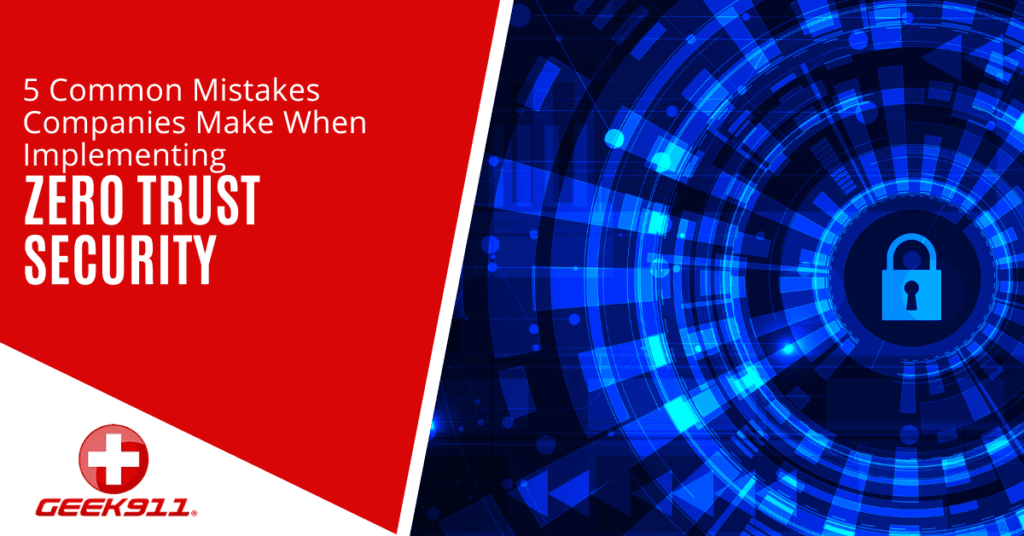5 Common Mistakes Companies Make When Implementing Zero Trust Security

In the evolving landscape of cybersecurity, where threats lurk around every digital corner, the concept of Zero Trust Security has emerged as a beacon of defense. Rooted in the notion that trust should never be assumed, this approach challenges traditional paradigms by scrutinizing every user, device, and network component seeking access to sensitive data or resources.
However, amid the zeal to fortify digital fortresses, companies often stumble upon common pitfalls that can undermine the efficacy of their Zero Trust implementations.
Here, we delve into some of the common mistakes companies make when implementing Zero Trust security and how to avoid them.
Mistake #1: Treating Zero Trust as a Product, Not a Strategy
Many organizations approach Zero Trust as a security product they can simply purchase and deploy. However, Zero Trust is a comprehensive security strategy, a fundamental shift in your cybersecurity philosophy. It requires a cultural transformation within your organization, emphasizing continuous verification and access control for all users, devices, and applications.
Here’s how to avoid this mistake:
- Focus on the “Why”: Educate your leadership team and employees on the evolving threat landscape and the limitations of traditional security models. Highlight the benefits of Zero Trust in safeguarding sensitive data and protecting your organization.
- Develop a Zero Trust Roadmap: Create a comprehensive roadmap outlining your transition to Zero Trust security. This roadmap should include key milestones, resource allocation plans, and training initiatives.
- Embrace a Culture of Continuous Improvement: Zero Trust implementation is an ongoing process. Continuously evaluate the effectiveness of your security measures, adapt to new threats, and foster a culture of security awareness within your organization.
Mistake #2: Overlooking User Experience
While prioritizing security is crucial, neglecting user experience can hinder the successful adoption of Zero Trust. Overly stringent security policies can lead to frustration among employees, hindering productivity. Finding a balance between security and user experience is essential.
Here are some tips:
- Involve Users in the Process: Get user feedback throughout the Zero Trust implementation process. Understand their pain points and concerns, and strive to implement security measures that are efficient and user-friendly.
- Prioritize Least Privilege Access: Grant users access only to the resources and data they need to perform their jobs effectively. This minimizes the potential damage caused by compromised credentials or malicious actors.
- Leverage Multi-Factor Authentication (MFA): MFA adds an extra layer of security to the login process, requiring a second factor beyond just a username and password. This significantly reduces the risk of unauthorized access, even if an attacker obtains a user’s credentials.
Mistake #3: Skipping the Inventory
Zero Trust security relies on a comprehensive understanding of your IT infrastructure – all devices, applications, and data stores. Without a complete inventory, you cannot effectively manage access controls or identify potential vulnerabilities. This is especially true in today’s hybrid and multi-cloud environments.
Here’s how to avoid this mistake:
- Conduct a Thorough Inventory: Identify all devices, applications, and data stores residing within your network, both on-premises and in the cloud. Use automated discovery tools to streamline this process.
- Maintain Continuous Visibility: Don’t treat the inventory as a one-time exercise. Develop processes to ensure your inventory remains up to date as your IT infrastructure evolves.
- Classify Your Data: Classify your data based on its sensitivity. This helps you prioritize security measures and determine the appropriate level of access control for different data types.
Mistake #4: Failing to Segment Your Network
Network segmentation is a critical component of Zero Trust security. By dividing your network into smaller segments, you limit the lateral movement of attackers within your network. This prevents a breach on one segment from compromising your entire network.
Here’s how to implement network segmentation effectively:
- Identify Segmentation Points: Analyze your network traffic and identify logical points to segment your network based on function or security requirements.
- Implement Access Controls: Enforce strict access controls between different network segments. Users and devices should only have access to the segments they need to perform their tasks.
- Continuously Monitor Network Activity: Monitor network activity for suspicious behavior within and between network segments. This allows for early detection of potential threats.
Mistake #5: Neglecting Security Awareness Training
Even with robust Zero Trust security measures in place, human error remains a significant security risk. Employees who fall victim to phishing attacks or social engineering tactics can unwittingly provide attackers with a foothold within your network. Security awareness training is crucial for mitigating this risk.
Here’s how to prioritize security awareness training:
- Regular Training Sessions: Conduct regular security awareness training sessions for all employees. Train them to identify common cyber threats, recognize phishing attempts, and practice safe password hygiene.
- Phishing Simulations: Simulate phishing attacks to test your employees’ awareness and preparedness. These simulations provide valuable insights into areas where additional training might be needed.
- Promote a Culture of Security: Foster a culture of security within your organization. Encourage employees to report suspicious activity and ask questions about security protocols.
The Road to Enhanced Security Starts with Awareness
Zero Trust security offers a powerful security framework in today’s digital age. However, successful implementation requires a strategic approach that avoids common pitfalls. By prioritizing user experience, maintaining a comprehensive inventory, segmenting your network, and investing in security awareness training, you can navigate the path towards Zero Trust with confidence.
Ready to Embark on Your Zero Trust Journey?
Consider seeking guidance from experienced cybersecurity professionals, like GEEK911. We can help your Silicon Valley area business develop a comprehensive Zero Trust strategy, identify and implement the right tools, and ensure a smooth transition for your organization.
Contact us today to schedule a consultation. Call 866-433-5411 or reach us online.
